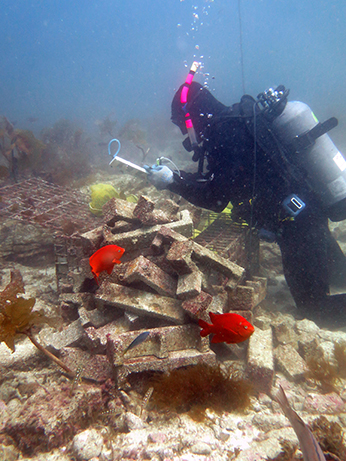Overview
 Scientific diver. CDFW photo by A. Maguire.
Scientific diver. CDFW photo by A. Maguire.
Scientific collection may be allowed within all marine protected area (MPA) designations for the purpose of research, restoration and monitoring; however, actual collection is dependent upon receiving a Scientific Collecting Permit. As specified in California Fish and Game Code and Title 14, California Code of Regulations (Sections 1002 and 650, respectively), a Scientific Collecting Permit is required when take1 or possession of fish and wildlife occurs for research, educational, or propagation purposes.
Effective on October 1, 2018, the SCP program implemented regulatory changes to Section 650 and Section 703, Title 14, California Code of Regulations. Changes include a new online application system through the scientific collecting permit portal and two permit types: General Use and Specific Use.
- The General Use permit is restricted to areas outside MPAs, more common species, non-invasive methods, and is intended for more streamlined review.
- The Specific Use permit covers a broader range of species, more invasive procedures, and sensitive locations within marine managed areas, including MPAs.
For further information on the application process and new permits, visit the CDFW Scientific Collecting Permits page.
1Take is defined in Section 86, California Fish and Game Code as "hunt, pursue, catch, capture, or kill, or attempt to hunt, pursue, catch, capture, or kill." Additionally, Section 650, Title 14, California Code of Regulations clarifies that takes also includes "capturing, marking, and releasing any animal."
Ecological Decision Framework
A ground swell of requests to undertake research inside MPAs has occurred after implementation of the Marine Life Protection Act. Since 2012, an average of 100 projects per year are permitted for monitoring, research, restoration and education in California’s MPA Network. To understand the cumulative impacts from these activities, CDFW collaborated with the California Ocean Protection Council’s Science Advisory Team to develop the ecological decision framework, which utilizes an assessment tool to quantify ecological impacts. This framework allows CDFW staff to make objective, quantitative, and transparent decisions on which applications to permit inside MPAs.
For further information on the ecological decision framework, please see the below linked technical report and peer reviewed paper.
Approved Project Lists
In order to enhance transparency and accessibility of approved CDFW Scientific Collecting Permit information, the following documents contain a detailed inventory of current 2017-2018 approved projects within MPAs. The project abstracts have been summarized from CDFW Scientific Collecting Permit applications and divided into three bioregions (North Coast, Central Coast, and South Coast) as identified by the MPA Monitoring Action Plan. Each regional document is organized with projects occurring in all MPAs first, followed by individual MPAs in alphabetical order.
North Coast (Oregon border to San Francisco Bay, including the Farallon Islands)
Central Coast (San Francisco Bay to Point Conception)
South Coast (Point Conception to the US/Mexico border)
To ask questions regarding conducting monitoring, research, restoration and educational activities within an MPA, please contact Lara Slatoff, Marine Region Environmental Scientist, at Lara.Slatoff@wildlife.ca.gov.